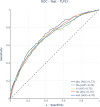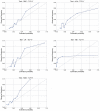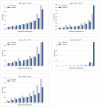Predicting target lesion failure following percutaneous coronary intervention through machine learning risk assessment models
- PMID: 38045434
- PMCID: PMC10689920
- DOI: 10.1093/ehjdh/ztad051
Predicting target lesion failure following percutaneous coronary intervention through machine learning risk assessment models
Abstract
Aims: Central to the practice of precision medicine in percutaneous coronary intervention (PCI) is a risk-stratification tool to predict outcomes following the procedure. This study is intended to assess machine learning (ML)-based risk models to predict clinically relevant outcomes in PCI and to support individualized clinical decision-making in this setting.
Methods and results: Five different ML models [gradient boosting classifier (GBC), linear discrimination analysis, Naïve Bayes, logistic regression, and K-nearest neighbours algorithm) for the prediction of 1-year target lesion failure (TLF) were trained on an extensive data set of 35 389 patients undergoing PCI and enrolled in the global, all-comers e-ULTIMASTER registry. The data set was split into a training (80%) and a test set (20%). Twenty-three patient and procedural characteristics were used as predictive variables. The models were compared for discrimination according to the area under the receiver operating characteristic curve (AUC) and for calibration. The GBC model showed the best discriminative ability with an AUC of 0.72 (95% confidence interval 0.69-0.75) for 1-year TLF on the test set. The discriminative ability of the GBC model for the components of TLF was highest for cardiac death with an AUC of 0.82, followed by target vessel myocardial infarction with an AUC of 0.75 and clinically driven target lesion revascularization with an AUC of 0.68. The calibration was fair until the highest risk deciles showed an underestimation of the risk.
Conclusion: Machine learning-derived predictive models provide a reasonably accurate prediction of 1-year TLF in patients undergoing PCI. A prospective evaluation of the predictive score is warranted.
Registration: Clinicaltrial.gov identifier is NCT02188355.
Keywords: Drug-eluting stent; Machine learning; Outcomes; Percutaneous coronary intervention; Target lesion failure.
© The Author(s) 2023. Published by Oxford University Press on behalf of the European Society of Cardiology.
Conflict of interest statement
Conflict of interest: M.A.M. receives unrestricted educational grant and consulting fees from Terumo; M.R. receives unrestricted educational grant from Terumo, Cordis/Cardinal Health, Medtronic, and Biotronik; O.F. receives speaker fees from Sanofi Pasteur; A.C. receives speaker fees from Abbott Vascular, Biosensor, and Boston Scientific, as well as consulting fees from Abiomed and Shock Wave Medical; D.P. is a former employee of Terumo Europe NV (Belgium); L.J. is an employee of Terumo Europe NV (Belgium); R.D. is a former employee of Terumo Europe NV (Belgium).
Figures




References
-
- Neumann FJ, Sousa-Uva M, Ahlsson A, Alfonso F, Banning AP, Benedetto U, et al. 2018 ESC/EACTS guidelines on myocardial revascularization. Eur Heart J 2019;40:87–16.
-
- Cutlip DE, Windecker S, Mehran R, Boam A, Cohen DJ, van Es GA, et al. Clinical endpoints in coronary stent trials: a case for standardised definitions. Circulation 2007;115:2344–2351. - PubMed
-
- Sianos G, Morel MA, Kappetein AP, Morice MC, Colombo A, Dawkins K, et al. The SYNTAX score: an angiographic tool grading the complexity of coronary artery disease. EuroIntervention 2005;1:219–227. - PubMed
-
- Farooq V, van Klavern D, Steyerberg EW, Meliga E, Vergouwe Y, Chieffo A, et al. Anatomical and clinical characteristics to guide decision making between coronary artery bypass surgery and percutaneous coronary intervention for individual patients: development and validation of SYNTAX score II. Lancet 2013;381:639–650. - PubMed
Associated data
LinkOut - more resources
Full Text Sources
Medical
Miscellaneous
